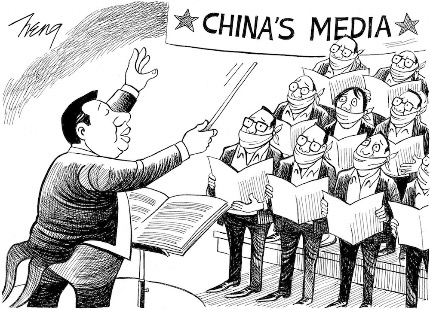A comprehensive study has revealed the deep-rooted and rapidly growing presence of government-scripted propaganda in China’s media landscape, painting a stark picture of journalism under President Xi Jinping’s rule.
The study, titled “The Decade-Long Growth of Government-Authored News Media in China under Xi Jinping,”investigates the expansion of centrally-scripted content in Chinese newspapers from 2012 to 2022. Published in the Proceedings of the U.S. National Academy of Sciences and discussed in the Stanford Center on China’s Economy and Institutions’ “China Briefs” on June 17, the research analyzes over 11 million articles across 700 party and commercial newspapers.
The findings are significant: articles written and distributed by the Chinese Communist Party’s (CCP) Propaganda Department—referred to as “scripted propaganda”—now constitute a substantial portion of newspaper content in China. These articles are often published word-for-word across various outlets, leaving little room for journalistic independence or localized storytelling.
In 2012, only around 5–7% of front-page content in party newspapers was classified as scripted. By 2022, that figure had surged to nearly 20%. In politically sensitive times such as Party anniversaries or national emergencies, the presence of scripted articles can spike to 30% of total content. Moreover, at least one scripted article appears on 90% of days in party newspapers, indicating the CCP’s continuous and systematic media control.
The researchers—Hannah Waight, Yin Yuan, Margaret E. Roberts, and Brandon M. Stewart—employed a novel computational method to identify clusters of nearly identical articles published across multiple newspapers on the same day. Their method was validated using over 1,000 leaked propaganda directives from China Digital Times, confirming that many articles were not just syndicated but state-mandated.
What sets this study apart is its focus on the evolving nature of propaganda. Scripted content is not limited to ideological pieces praising Party achievements or promoting Xi Jinping Thought. It also includes topics such as health, disasters, crime, and lifestyle—areas that help the state subtly shape public opinion on everyday matters.
The COVID-19 pandemic offered a clear example. Instead of transparent reporting, newspapers were flooded with scripted articles reinforcing state authority, downplaying uncertainty, and silencing dissent. Such strategies enabled the government to manage the public narrative, especially during crises.
The study also challenges assumptions about media diversity in China. Commercial newspapers—once viewed as relatively independent—are now frequently publishing state-authored articles. This blurs the line between party-controlled and private media, consolidating the CCP’s grip over the entire information ecosystem.
The increasing volume, consistency, and breadth of scripted propaganda point to a major transformation: a shift from even nominal editorial independence to total ideological alignment with the central government. As China exports its media model through initiatives like the Digital Silk Road, understanding the mechanics of its domestic propaganda becomes a crucial geopolitical concern.
In essence, China’s media under Xi Jinping no longer serves as a watchdog or independent public forum—it has become a tool of centralized messaging, finely tuned to present an illusion of diversity while delivering a singular, state-sanctioned narrative.





